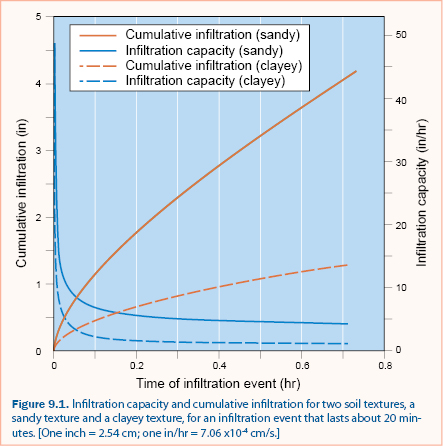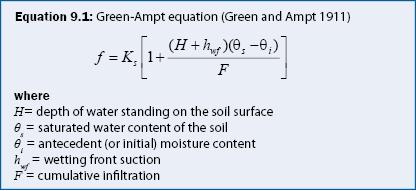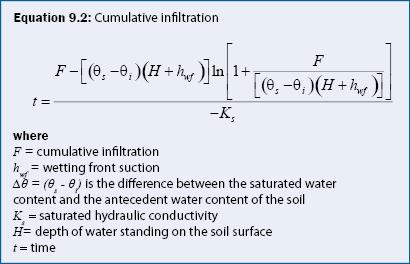
Infiltration Practices
J.L. Nieber, A.J. Erickson, P.T. Weiss, J.S. Gulliver, R.M. Hozalski
Process
Infiltration practices operate by capturing and temporarily storing stormwater, before allowing it to infiltrate into the underlying soil. The infiltrated water is then partitioned into groundwater recharge, discharge through an underdrain (if applicable), and transpiration. By performing this process, these practices provide two fundamental functions in stormwater management: attenuation of runoff volume and treatment of the runoff. These functions may ultimately reduce stormwater pollutants, increase groundwater recharge, decrease runoff peak flow rates, and decrease the volume of stormwater runoff.
Infiltration rates in infiltration basins and trenches need to be small enough to promote the retention and treatment of pollutants and nutrients, while large enough to avoid prolonged periods of ponded water and the development of anaerobic conditions. The Minnesota Stormwater Manual states that soil permeabilities must be at least 0.2 inches (1.27 centimeters) per hour and, according to the Wisconsin Stormwater Manual (broken link) at most 5.0 inches (12.7 centimeters) per hour. This typically limits application to some but not all soils in Hydrologic Soil Groups A, B, and C (Minnesota Stormwater Manual). Soil infiltration rates can initially be estimated from National Resources Conservation Service (NRCS) soil data but should be confirmed by an on-site geotechnical investigation. For guidance on investigation procedures, see Chapter 12 of the Minnesota Stormwater Manual.
The rate that water will infiltrate into the soil is dependent on textural characteristic of the soil profile, the condition of the soil surface, and the initial moisture content within the soil profile at the time of the infiltration event. The soil’s textural characteristics determine the saturated hydraulic conductivity of the soil and the water retention or storage characteristics of the soil. Naturally, soils that have a relatively coarse texture will tend to have greater saturated hydraulic conductivity than fine–textured soils, and so these coarse-textured soils will tend to have greater infiltration capacities. The condition of the soil surface is important because effects such as compaction of the surface layers or deposition of fine particulates onto the surface can reduce the hydraulic conductivity of the surface and thereby reduce the infiltration capacity of the soil. The initial moisture content of the soil is an important factor in determining infiltration capacity: the drier the soil is at the beginning of an infiltration event, the more capacity the soil has to absorb the water available at the soil surface.
The infiltration capacity of soil varies with time during the infiltration event. It is larger at the very beginning of the event and decreases (usually exponentially) with time during the event. If the soil profile is deep, the water table is low, and low-hydraulic conductivity layers within the profile are not present, the lower limit of infiltration will be equal to the saturated hydraulic conductivity of the soil profile.
The effectiveness of infiltration practices is tied to maintaining the designed infiltration rate of the structure, which influences the ability of the soil to remove pollutants (Pitt et al. 1996). Commonly cited reasons for the failure or decreased effectiveness of infiltration structures include surface clogging, poor site selection, and soil compaction (Gregory et al. 2006). As the infiltration capability of the soil is compromised through clogging or compaction, the effectiveness of the infiltration practice will decrease, leading to prolonged periods of inundation with minimal or no treatment of stormwater pollutants.
Fate of contaminants after infiltration
While solid contaminants are typically removed at the soil surface or within the soil matrix through physical straining or filtration, removal of the dissolved contaminants typically occurs within the soil matrix through adsorption to solid particles or biological transformation. With any infiltration system, however, there exists the potential for groundwater contamination. Several studies have investigated soil and groundwater contaminant concentrations underneath or adjacent to stormwater treatment practices that infiltrate water. Karst soils are typically susceptible to groundwater contamination, but a review of relevant publications (Weiss and LeFevre 2008) found that most contaminants are typically removed before the infiltrated water reaches groundwater aquifers.
Much of the metal contaminant load in stormwater runoff is bound to solid particles and is removed through sedimentation or physical straining. The literature, as summarized by Weiss and LeFevre (2008), indicate that infiltrated dissolved metals are typically adsorbed in the upper layer of soil (50 cm or less) but due to the limited adsorption capacity of the soil, breakthrough may eventually occur. To prevent breakthrough, replacement of the upper soil layers may be necessary every 3 to 5 years, but some studies have shown the frequency may be much less often than 5 years (Weiss and LeFevre 2008).
Hydrocarbons are also removed in the top layers of soil, especially by mulch that, because of its large lignin content, has a strong affinity for nonionic organic compounds. Dissolved phosphorus can sometimes be removed by soil after infiltration occurs, but it is not uncommon for studies to find a negative phosphorus removal rate (i.e. an increase in infiltrated runoff phosphorus concentration) in some infiltration systems (Weiss and LeFevre 2008).
Nitrate is very soluble and typically is not removed from runoff by infiltration practices. Nitrate concentrations in urban runoff are relatively small, and therefore groundwater contamination, although documented, has not been a significant problem. Finally, it is known that soil media has no appreciable retention of salts. Thus, salts have a large potential for groundwater contamination and documented cases of groundwater contamination by salts exist (Weiss and LeFevre 2008). Placement of the infiltration device largely dictates the influence of saline pollution.
The effect of soil texture on infiltration capacity is illustrated in figure 9.1, which compares the infiltration capacity and cumulative infiltration for two soil textures, a sandy texture and a clayey texture, for a period of about 20 minutes. These plots were created using equation 9.1 for the infiltration capacity and equation 9.2 for the cumulative infiltration. It is seen from the graph that the sandy textured soil has a much greater infiltration capacity than the clayey soils; therefore, the cumulative infiltration during the 20-minute infiltration event is much greater for the sandy texture (5 inches (12.7 centimeters) compared to 1.2 inches (3.05 centimeters)).
The infiltration capacity is seen to decrease exponentially for each of the soil textures, with the capacity approaching the saturated hydraulic conductivity for each soil. For the sandy soil, the saturated hydraulic conductivity is 3 in/hr (0.002 cm/s), while for the clayey soil the saturated hydraulic conductivity is 0.2 in/hr (1.41 x 10-4 cm/s). For each of the cases shown, the lower limit of infiltration capacity is not reached, though the leveling off of the infiltration capacity does indicate that the lower limit is being approached.
Practices
Infiltration practices utilize porous materials to facilitate infiltration of stormwater into soils. Stormwater is channeled into the infiltration practice, where it is stored temporarily before it penetrates the underlying soil. Infiltration into the soil facilitates the removal of pollutants through chemical and bacterial degradation, sorption, and filtering.
The U.S. EPA (1999a) reports that infiltration trenches typically occupy 2-3% of the total impervious area within the watershed, while Claytor and Schueler (1996) report infiltration practices typically occupy 2-3% of the total watershed area. Many studies have documented the effectiveness of pollutant removal in properly functioning infiltration practices (Schueler 1987, Schueler 1992, U.S. EPA 2000, Winer 2000). Pollutant removal efficiencies from three of these studies are shown in table 9.1.
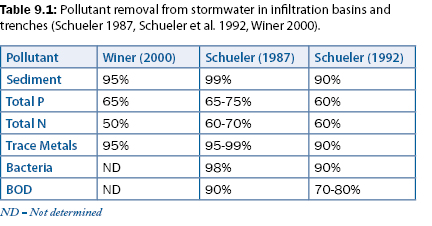
Infiltration basins
An infiltration basin is a natural or constructed impoundment that captures, temporarily stores, and infiltrates the design volume within an acceptable time period. Infiltration basins often contain a flat, densely vegetated floor situated over naturally permeable soils. Nutrients and pollutants are removed from the infiltrated stormwater through chemical, biological, and physical processes. Infiltration basins are well suited for drainage areas of 5 to 50 acres (2.03–20.25 hectares) with land slopes that are less than 20 percent, with typical depths in the basin ranging from 2 to 12 feet (0.61–3.66 meters) (Minnesota Stormwater Manual). A typical infiltration basin is shown in figure 9.2.
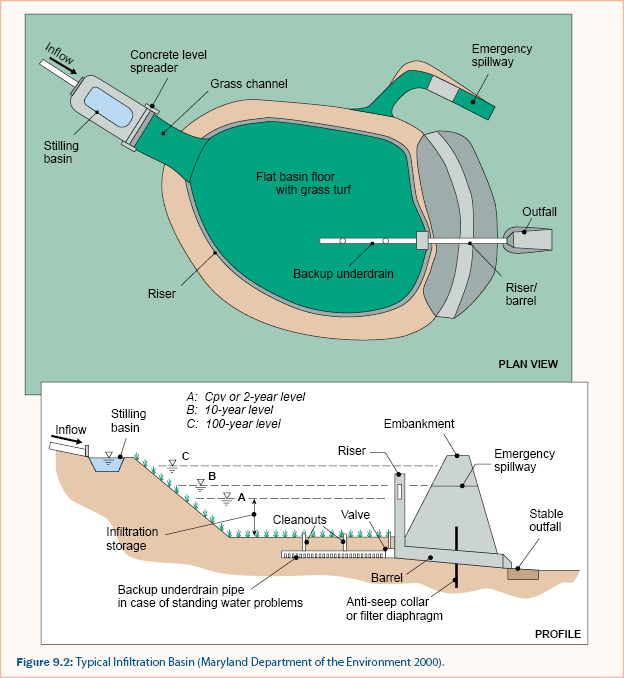
Infiltration trenches
An infiltration trench is a shallow excavated trench, typically 3 to 12 feet deep (0.91–3.66 meters), that is typically backfilled with a coarse stone aggregate allowing for the temporary storage of runoff in the void space of the material. Discharge of the stored runoff occurs through infiltration into the surrounding naturally permeable soil. Infiltration trenches are well suited for drainage areas of 5 acres (2.03 hectares) or less (Minnesota Stormwater Manual). A typical infiltration trench is shown in figure 9.3.
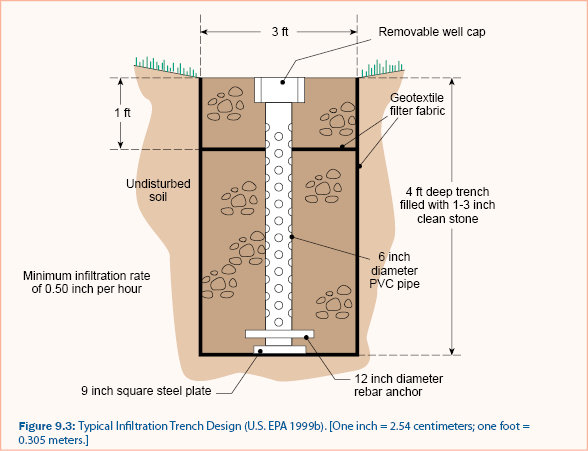
Permeable pavements
While most would consider permeable pavements to be composed of either asphalt or concrete materials, there are actually nine categories of materials that fall within the definition of permeable (or porous) pavement (Ferguson 2005). These include permeable aggregate, permeable turf, plastic geocells, open-jointed paving blocks, open-celled paving grids, permeable concrete, permeable asphalt, soft permeable surfacing, and decks.
For the case where the permeable pavement is either asphalt or concrete, the pavement system is designed so that stormwater infiltrates through the permeable upper pavement layer and then into a reservoir of stone or rock below. Water from the reservoir then either percolates into the underlying soil, eventually recharging groundwater, or is collected by a perforated pipe underdrain system and carried to a surface discharge location. An illustration of a vertical section through an asphalt permeable pavement is presented in figure 9.4.
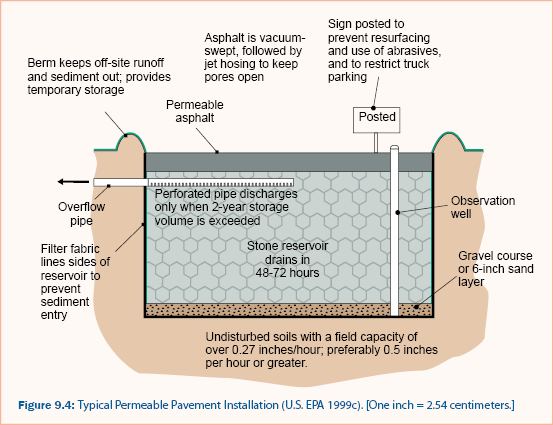
Frequency of use
A survey (Erickson et al. 2009) designed to collect information related to stormwater treatment practice use in Minnesota and Wisconsin revealed that 67% of the municipalities that responded to the survey had at least one infiltration basin, 52% had at least one site with permeable pavement, and 62% had at least one filter strip or swale. Table 9.2 shows more details of the survey results pertaining to use of infiltration practices.
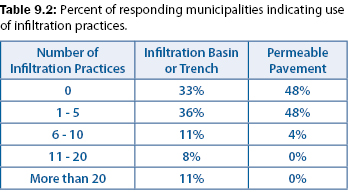
Assessment
The infiltration capacity of stormwater treatment practices can be evaluated by all four levels of assessment. These approaches vary in level of difficulty, ranging from simple to complex, and in level of resource demand, from inexpensive to expensive. Infiltration practices can be evaluated by all four levels of assessment: Visual Inspection, Capacity Testing, Synthetic Runoff Testing, and Monitoring. Discussion and recommendations for applying each of these methods to infiltration practices can be found by clicking on the preceding links, or the drop-down items under Infiltration Practices on the main menu.
Continue to Visual Inspection.

